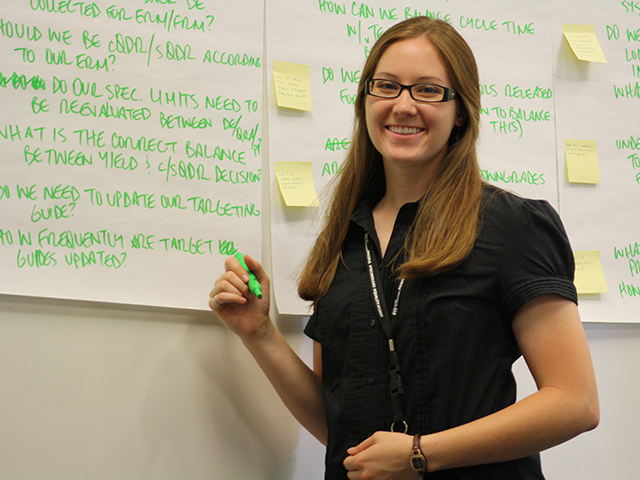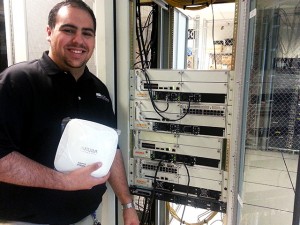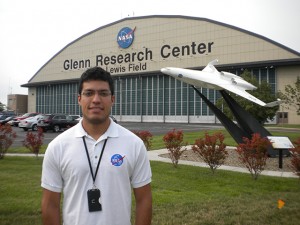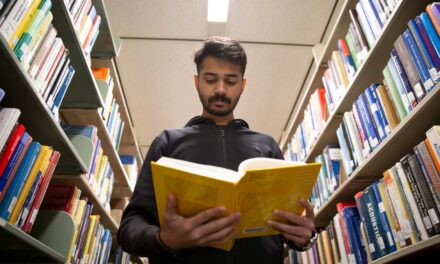
Summer internships helped engineering students step onto career path

Industrial engineering major Brittney Reyman helped ensure the efficiency of operations for a semiconductor fabrication company.
Posted September 18, 2013
Many students in Arizona State University’s Ira A. Fulton Schools of Engineering are as busy on their summer “breaks” as they are during semesters when they’re taking full loads of courses.
That’s true especially for those who land sought-after summer internships with leading high-tech companies, government agencies and research institutions that put their budding engineering skills to the test.
Pressure, challenges and time-consuming work come with such intern assignments. But the reward is the opportunity to take valuable first steps on promising career paths.
Here, four ASU engineering students tell about their recent summer internship experiences:
# # #
Brittney Reyman is on course to graduate from ASU this semester with a degree in industrial engineering. Reyman grew up in Mesa, Ariz., where she graduated from Red Mountain High School in 2007. She worked a summer internship with IM Flash in Lehi, Utah. The company, which employs about 1,600 people, is a joint venture of major semiconductor manufacturers Intel and Micron.
Getting the job: I made contacts at the ASU Career Fair events that got me connected to people at IM Flash who were involved in the recruiting and hiring process for the company’s internships.
I learned that IM Flash wanted to hire only one industrial engineering intern for the summer and the company was collecting résumés from students at several universities. I ended up being the right fit for that one industrial engineering position.
Job duties: My assignment was with a small team that defines and manages quality standards for the entire operation. I led small teams from each of the semiconductor fabrication areas through various problem-solving exercises. The goal was to address root causes of deviation reports and reduce the quantity of those reports from these fabrication areas.
Deviation reports document product quality defects. It would be misleading to say I was striving to reduce the quantity of product defects because the reports document instances of potential defects – not necessarily defects, scrap or downgraded material quality (which are all different categories). These reports are filed to note a deviation that occurred in the process so a decision can be made as to what to do with the product.
My project required multiple meetings to take place between each step, so I was given an additional assignment to better utilize my time between project meetings. That assignment was to develop a site-wide training document regarding a documentation system that is being introduced at the company.
Challenges: One of the more challenging things was managing where each team was in the problem-solving process and making sure I had made the appropriate adjustments to my strategy prior to meeting with each team.
The teams went through a series of meetings to complete the problem-solving exercises, and sometimes they did not work as well as I had intended, or the teams had constructive feedback to give me. I then adjusted what did not work well and integrated the feedback into my approach for the next team. This sometimes meant I had only a few hours to adjust my strategy before meeting with the next team. Managing this successfully required me to rely on skills I learned in my project management class at ASU, which included documenting my project thoroughly.
Best part of the job: The best part of my internship experience was being able to meet so many different people at various levels across the company. I worked closely with many of them to achieve a goal that would benefit both of our departments. I believe building that type of relationship as an intern is a huge stepping-stone to being successful, especially if I have the opportunity to return to the company full-time after graduation.
I also had the opportunity to meet others outside of those teams, largely because many of the employees at this site were open to talking with interns and sharing their insights with students. It was easy for me to ask for a few minutes of someone’s time and ask questions about their schooling, career background and life planning.
Lessons learned: One of the most important things I learned from this internship is how to manage a project involving a large number of people, how asking the right questions is the key to getting the answers you want, and how important it is to network.
It was important that I understood the challenges each team faced in its area so that I could ask relevant questions, and sometimes gaining that understanding meant asking some dumb questions. If I were afraid to do that, eventually I would get too lost to be able to do my job effectively.
I also learned about the value of networking. Getting to know so many people in the company, and learning what they worked on, helped me to connect the bits of information I was learning about the manufacturing processes. Knowing more about those interactions helped me understand the bigger picture and how everything fit together.
My advice on making the most of an internship is to get to know people, and to be a little fearless about it. Don’t be fearful because you are only an intern. Be confident in your skills and kindly ask your coworkers to share their insights with you.
# # #

Computer systems engineering major Nick DePalma says his internship provided the opportunity to do important work to improve computer network operations for American Express.
Nick DePalma is a senior computer systems engineering major, with a focus on information security. He grew up in Gilbert, Ariz., and graduated from Mesquite High School in 2010. DePalma’s summer internship was in Phoenix, working with technology division of the multinational financial services company American Express.
Getting the job: Before the spring semester Engineering Career Fair, I was applying like crazy for jobs. My father, who is an engineer, suggested that I apply to American Express. At the career fair, I was about to leave when I noticed the American Express booth was not that busy, so I spoke with the representative and gave her my resume. A week later I got an e-mail offering me an interview.
The interview consisted of two 45-minute behavioral interviews at the Engineering Career Center at ASU. I got an e-mail a couple days later saying that I made it to the second round of interviews. There were about 40 students at the second round of interviews. Twelve of us got offers, so you could say the hiring was competitive.
Job duties: I was part of the Network Operations Performance and Availability business group. We were responsible for the overall health of the American Express network and infrastructure. My role consisted of working with the Tools team and the Wireless team.
For the Tools team, I worked with Network Alert Monitoring software that would push alerts whenever some part of the network was not functioning correctly. I taught myself Visual Basic and wrote a script to automate a process that used to take 10 hours, but now takes 10 minutes.
For the Wireless group, I helped with the rollout of the new wireless standard for all of Phoenix and the New York World Financial Center. I performed baseline tests of the old system in Phoenix, and then when the team implemented the new wireless system I performed the same tests to prove that the new system is an improvement over the old one and was a wise investment.
Work environment: People in the group I worked with were extremely welcoming. From my first day, I was treated as a full-time employee and included in vital business decision-making.
The interns didn’t work on the same projects as each other, but when I was doing my wireless testing I enlisted the help of a couple of other interns to test the conference-call qualities of a specific application. We all got along well, and the internship leader organized various events for us, including bowling, cooking class, a Diamondbacks game, a volunteer event and happy hours.
Challenges: The most difficult part was during the systems testing. I had to rely on other people for certain performance metrics, and it was tough making sure I got all the data I needed before the deadline.
Best part of the job: The best part was being exposed to the different kinds of things being done by my coworkers in the technical group. If I wasn’t particularly busy, members of my group would take me to different engineering labs, or give me tours of the data center.
Another great part was that it was immediately apparent that the work that I was doing was critical to the group. The Tools group work I did drastically saved time and changed the work landscape, and the Wireless group work I did established a new standard and paved the way for a more mobile work environment throughout American Express.
Lessons learned: The main thing I learned was how to leverage other people to help with my work. ASU gives me all the technical skills I could want, but on-the-job experience is the thing that will give you the tools you need to work with other people.
This internship will open up many doors for me. I believe that the work I did and the connections I made make me a hot commodity within the engineering world.
My advice for other students is to never stop applying for jobs and to never get discouraged. If you cast a wide net, companies will come to you. I had four interview offers after I accepted the American Express internship, and that was because my resume had been in the system since November.
I also highly suggest getting professional résumé help from someone in ASU’s Engineering Career Center.
# # #

Aerospace engineering graduate student Daniel Oliden tested his skills in a summer internship for a NASA research center.
Daniel Oliden is set to graduate this semester with master’s degree in aerospace engineering, with a focus on aerodynamics and fluid dynamics. He’s an Arizona native who graduated in 2004 from Desert Vista High School in Ahwatukee. He did a summer internship with the National Aeronautics and Space Administration (NASA) Glenn Research Center in Cleveland, Ohio.
Getting the job: I applied online through a NASA application web page, called NASA Academy. I heard about it by looking online at NASA’s opportunities for graduate students. I had a connection with NASA through experience I got at ASU, including research and leadership experiences with student clubs. Oliden is a past vice president of the Air Devils, a student aeronautics team. The hiring was very competitive. Thousands of people applied and only 19 were accepted.
Job duties: I worked on computational fluid dynamics of complex three-dimensional geometries of ice-accretion on aircraft surfaces. I worked in the Icing Branch at NASA Glenn Research Center, running in-house NASA computational fluid dynamics codes. I worked closely with two mentors. A famous icing research wind tunnel is located in the building I worked in, which is where the ice-accretion geometries I was working on were laser-scanned.
Work environment: NASA Academy is strongly based on team building and group projects. Therefore, we had two projects. One was a team project, which involved my research with the icing branch. The other was a group project, which was worked on by all the Aeronautics Academy interns. We designed a methane-breathing aircraft to fly in the atmosphere of Titan (the largest moon of Saturn). We worked closely and built strong friendships with each other. The group members were from all around the country, from New York to Albuquerque.
Challenges: The most challenging thing was managing my time. The NASA Academy internship is an intense experience, particularly because of having to work on two big projects. The team project was worked on during regular business hours, but the group project was worked on during our own time after work. Besides that, we attended frequent presentations by speakers from NASA and the Ohio Aerospace Institute, and we went on tours of such company and government facilities as General Electric, Rolls Royce, Astrobotics, Parker Hannifin and Wright Patterson Air Force Base. All this kept us extremely busy.
Best part of the job: The best part was keeping us busy. Even though it was intense, it was packed with many learning activities and networking with professional engineers.
I met many amazing and intelligent people from all areas of engineering. I toured the latest and greatest aerospace laboratories and facilities.
I also very much enjoyed having a close relationship with all the other NASA Academy interns. We learned a lot about each other, shared experiences, debated about the future of aerospace, and became close friends.
My previous internships have never emphasized team building as much as this one, and I appreciate that it did.
Lessons learned: Read up on the kind of work you will be expected to do in your internship before you start the job. Don’t be afraid to ask questions. Socialize with other interns and coworkers, both at work and outside of work.
# # #

Biomedical engineering major Andrew Dobos gained experience in nanobioscience research during a summer internship.
Andrew Dobos is a senior majoring in biomedical engineering. He graduated in 2010 from McClintock High School in Tempe, Ariz. He did a summer internship with the Translational Genomics Research Institute (TGen), conducting research at the University of Arizona Center for Applied NanoBioscience and Medicine in Chandler.
Getting the job: I got the internship through TGen’s Helios Scholars summer internship program. The program is open to Arizona high school seniors, college graduate and undergraduate students, and medical school students. I was told that almost 500 students apply to participate each year, and that I was one of 45 selected this year.
Job duties: TGen focuses on creating and optimizing techniques for diagnostics and treatments. It is at the forefront of personalized medicine, which aims to diagnose and treat diseases based on each individual patient’s needs. I worked, along with my mentor Dr. Cedric Hurth, on characterizing the effects that certain biomolecular interactions have on the drying mechanism of liquid droplets. This involved depositing microdroplets onto a coated and a noncoated microscope slide via pipette and observing the changes in the drying process due to the presence or absence of the slide coating.
I also constructed polydimethylsiloxane (PDMS) flow cells, into which the solution in question was flushed. The solution contained beads coated with a vitamin or a protein. The beads were allowed to deposit onto the coated-slide surface of the flow cell and flushed with water at increasing rates to determine the adhesive force that each solution (bead) had with the coated-surface. Various techniques were employed and numerous flow cell devices were created. The method used to visualize the interactions was florescence microscopy, as the beads were fluorescently tagged.
I worked in a standard laboratory setting. The device I became most familiar with was the microscope, which I used to observe all the experiments. I constructed the flow cells in a class 100 clean room, which required wearing a hair net, face mask, goggles, lab coat, gloves and shoe covers. I also worked with a piezoelectric droplet dispenser, a plasma treatment chamber and an ultrasonic cleaner.
Challenges: My experiments consisted of a lot of trial and error. It was often days and even weeks before I would obtain results that my mentor and I found sufficient. The experimental process was often slow, and it required much patience. However, this is necessary to avoid making redundant errors.
Best part of the job: I was excited to gain hands-on experience in such a welcoming environment. I was constantly surrounded by scientists who are working to make a positive impact on the lives of others.
I feel I am walking away not only with the skills to work in a laboratory, but also the knowledge of why such work is useful and necessary. I have gained a deeper appreciation for the work conducted by these men and women and am glad that I could be a part of it.
I now also have many new colleagues and friends in my field, many of whom I look forward to seeing and working with in future.
Lessons learned: This internship taught me a lot about the nature of scientific research. I hope to apply this knowledge, along with laboratory skills I’ve gained, in future lab work.
The advice I would give to other students about working internships is to ask questions of people in your field and people you are working with. Many students avoid this. They think it makes them appear unintelligent. I have found that the opposite is true. Asking questions shows mentors that you are truly curious and engaged, and focused on the task at hand.
Media Contact
Joe Kullman, [email protected]
(480) 965-8122
Ira A. Fulton Schools of Engineering



































